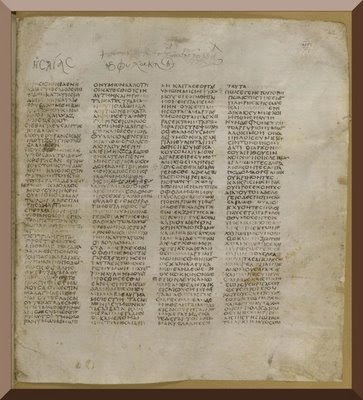
A 1,600 year old manuscript of the Bible has for at least the last 150 years, been in four separate locations around the world. It is known as “The Codex Sinaiticus”, named after the Monastery of Saint Catherine, Mount Sinai, Egypt. The name 'Codex Sinaiticus' means 'the Sinai Book'. Leaves and fragments of the Codex were taken on three occasions, in 1844, in 1853 and in 1859, so that they could be published. The largest surviving portion of the Codex, comprised of 347 leaves, was purchased from the Soviet government in 1933, and is now held by the British Library. An additional 43 leaves are held at the University Library in Leipzig, Germany, and parts of six leaves are held at the National Library of Russia in St. Petersburg. Twelve leaves and forty fragments remain at Saint Catherine’s Monastery, where they were recovered by monks in 1975.
The Codex Sinaiticus was hand-written in Greek by three (possibly four) scribes in the mid-fourth century, around the time of Constantine the Great. The Codex was originally around 1,400 pages long, is now a collection of 800 pages and fragments. The text, written on vellum (high quality parchment made from calfskin, kidskin, or lambskin) and the pages that have survived include the entire New Testament and the earliest surviving copy of the Gospels, written after Christ’s death by Matthew, Mark, Luke and John. Half of a copy of the Old Testament is also among the pages that remain. The rest has been lost over time.
The Codex Sinaiticus was hand-written in Greek by three (possibly four) scribes in the mid-fourth century, around the time of Constantine the Great. The Codex was originally around 1,400 pages long, is now a collection of 800 pages and fragments. The text, written on vellum (high quality parchment made from calfskin, kidskin, or lambskin) and the pages that have survived include the entire New Testament and the earliest surviving copy of the Gospels, written after Christ’s death by Matthew, Mark, Luke and John. Half of a copy of the Old Testament is also among the pages that remain. The rest has been lost over time.
The Greek Septuagint in the Codex includes books not found in the Hebrew Bible and regarded by Protestants as apocryphal, such as 2 Esdras, Tobit, Judith, 1 & 4 Maccabees, Wisdom and Sirach. The two other early Christian texts are an Epistle by an unknown writer claiming to be the Apostle Barnabas, and 'The Shepherd', written by the early second-century Roman writer, Hermas. The number of the books in the New Testament is the same as that in modern Bibles in the West, but the order is different. The Letter to the Hebrews is placed after Paul's Second Letter to the Thessalonians, and the Acts of the Apostles between the Pastoral and Catholic Epistles.
Only one other manuscript of the Christian Bible, the Codex Vaticanus (kept in the Vatican Library in Rome) is of a similarly early date.
Only one other manuscript of the Christian Bible, the Codex Vaticanus (kept in the Vatican Library in Rome) is of a similarly early date.
In March of 2005, the British Library, the University Library in Leipzig, Germany, the National Library of Russia in St. Petersburg, and the Holy Monastery of Sinai signed a Partnership Agreement “for the conservation, photography, transcription and publication of all surviving pages and fragments of Codex Sinaiticus”.
The organizations from Great Britain, Germany, Russia and Egypt who each owned parts of the 1,600-year-old manuscript, have worked together to publish research into the history of the Codex. During a four-year period, they have transcribed over 650,000 words.
To see this manuscript yourself, and read about the work being done for this great project, go to:
The organizations from Great Britain, Germany, Russia and Egypt who each owned parts of the 1,600-year-old manuscript, have worked together to publish research into the history of the Codex. During a four-year period, they have transcribed over 650,000 words.
To see this manuscript yourself, and read about the work being done for this great project, go to:
http://www.codexsinaiticus.org/en/
Catholic
Religion
Church
Roman Catholic
Catholic Church
Catholic Blogs
Codex Sinaiticus
